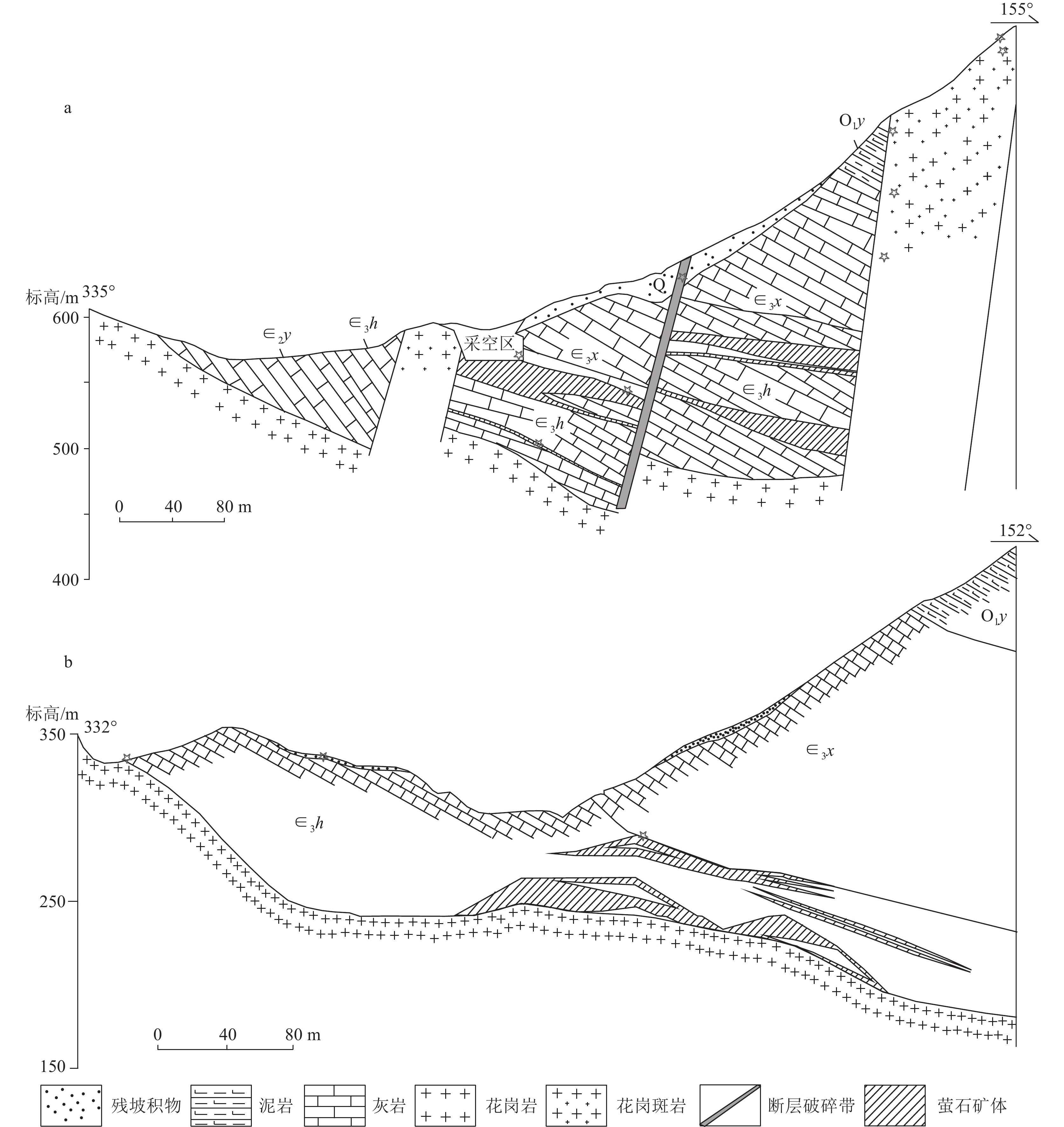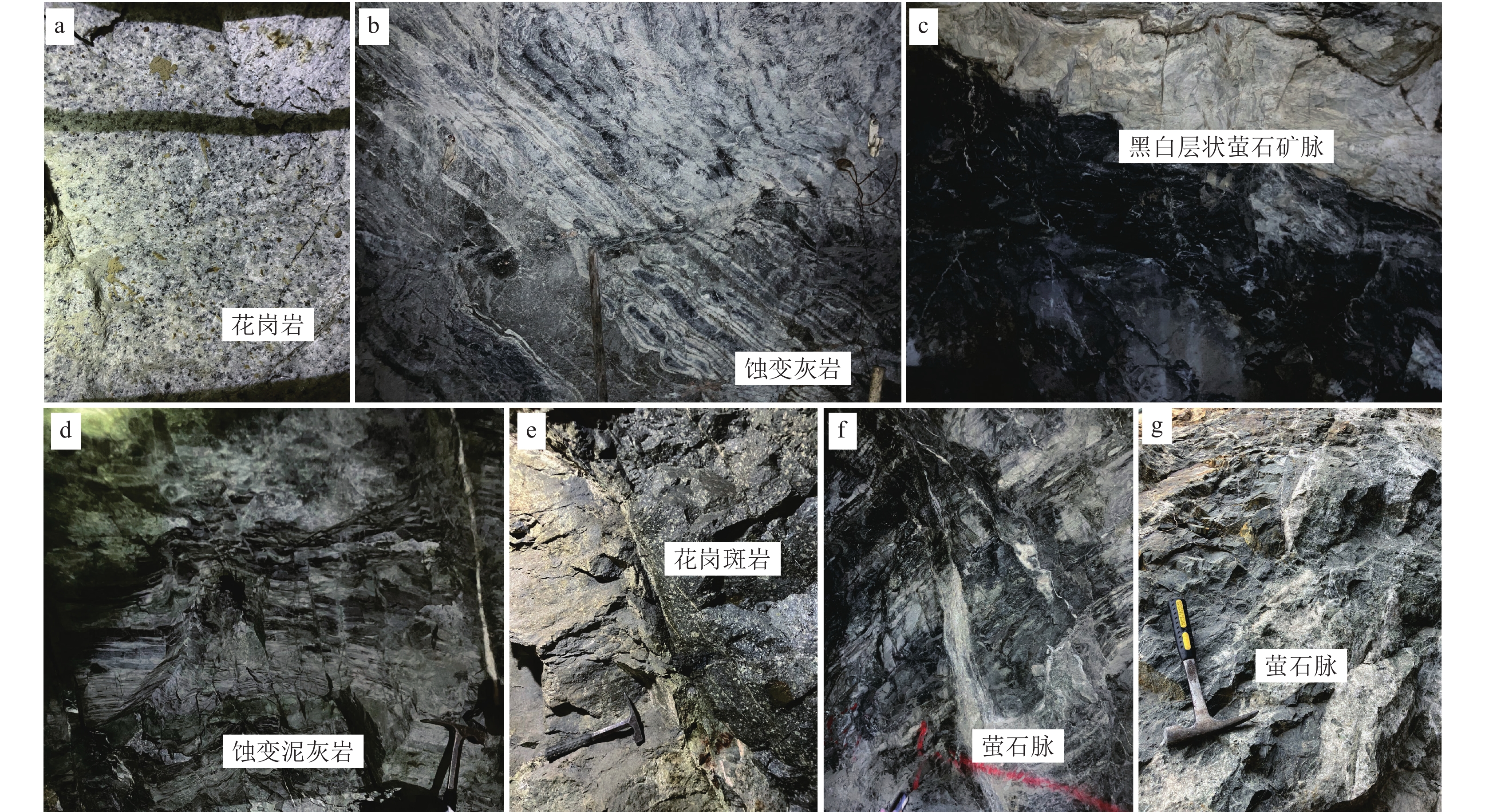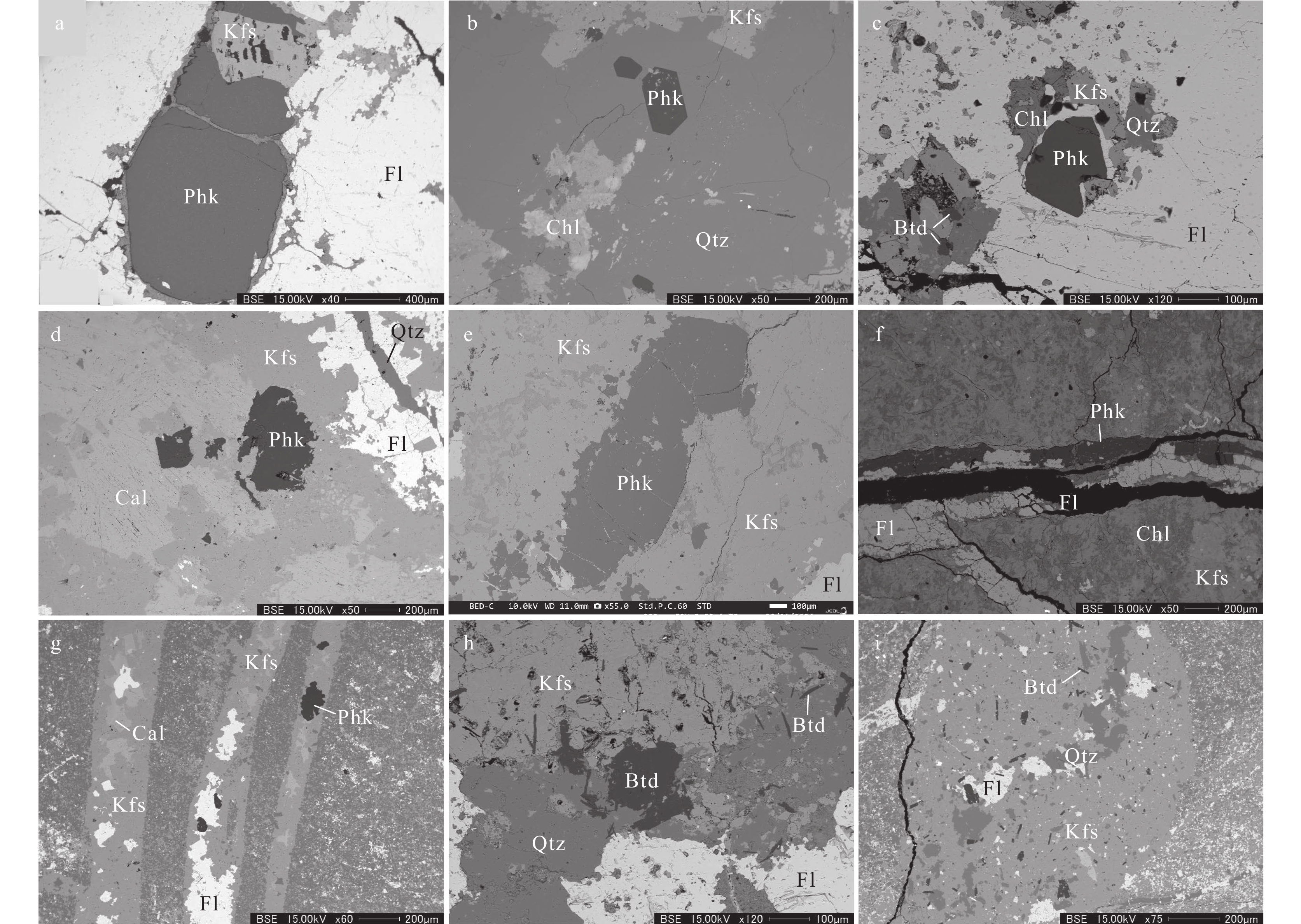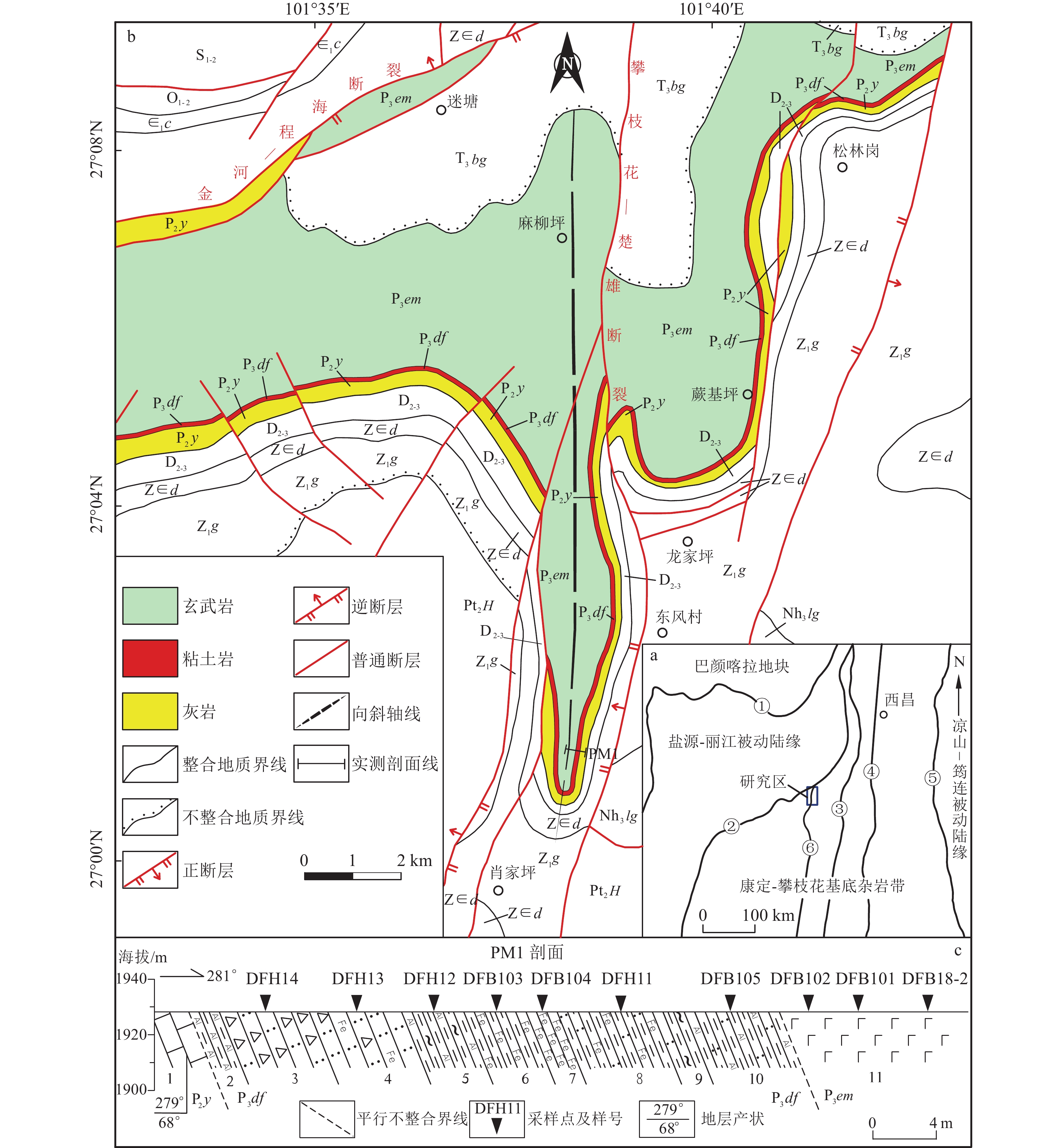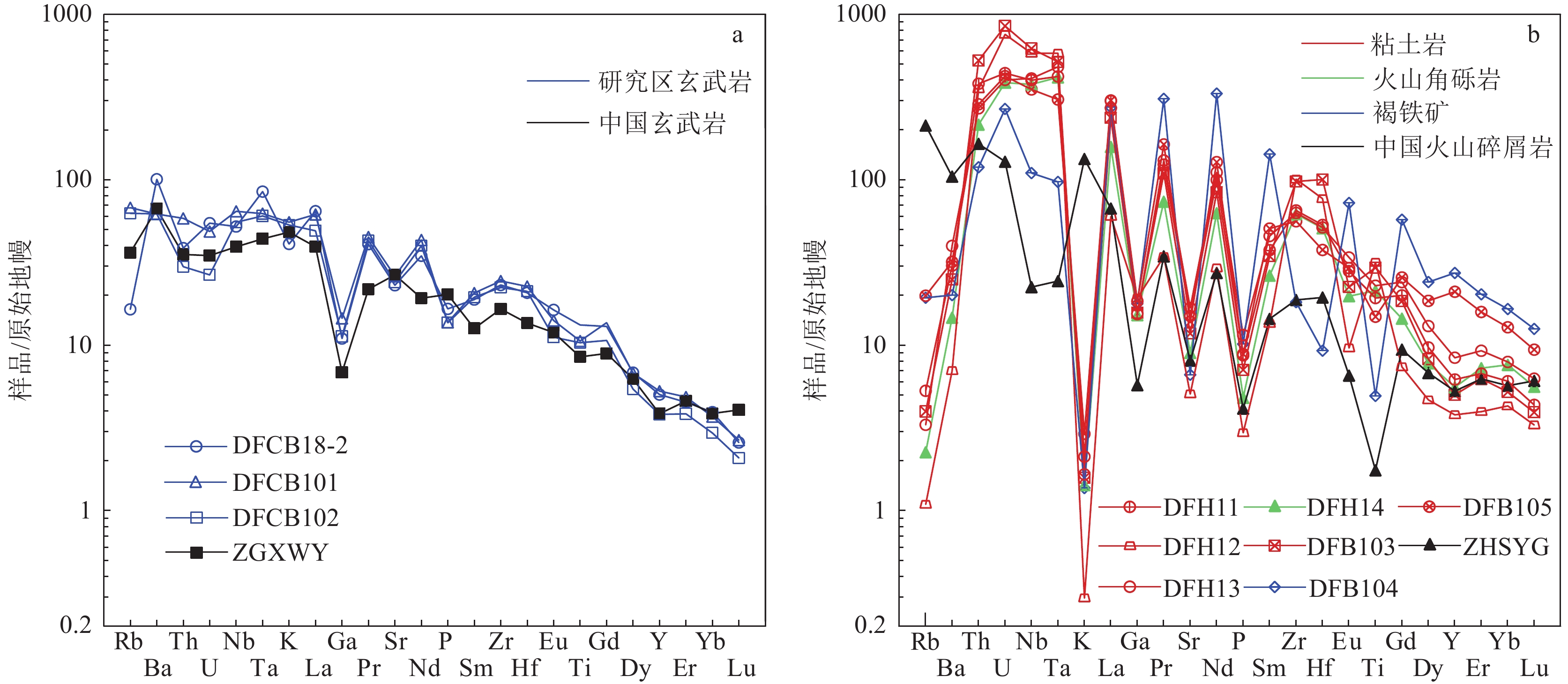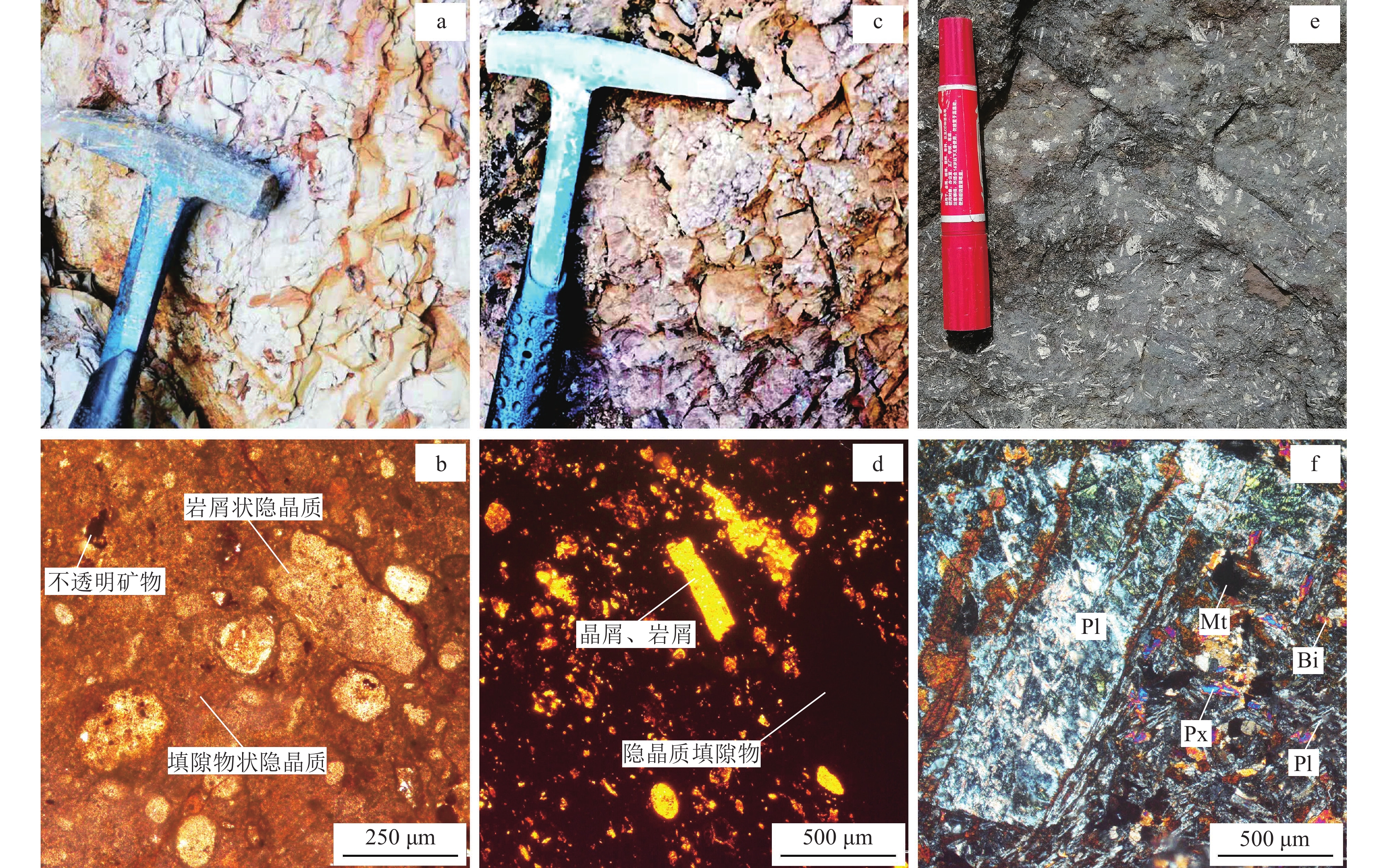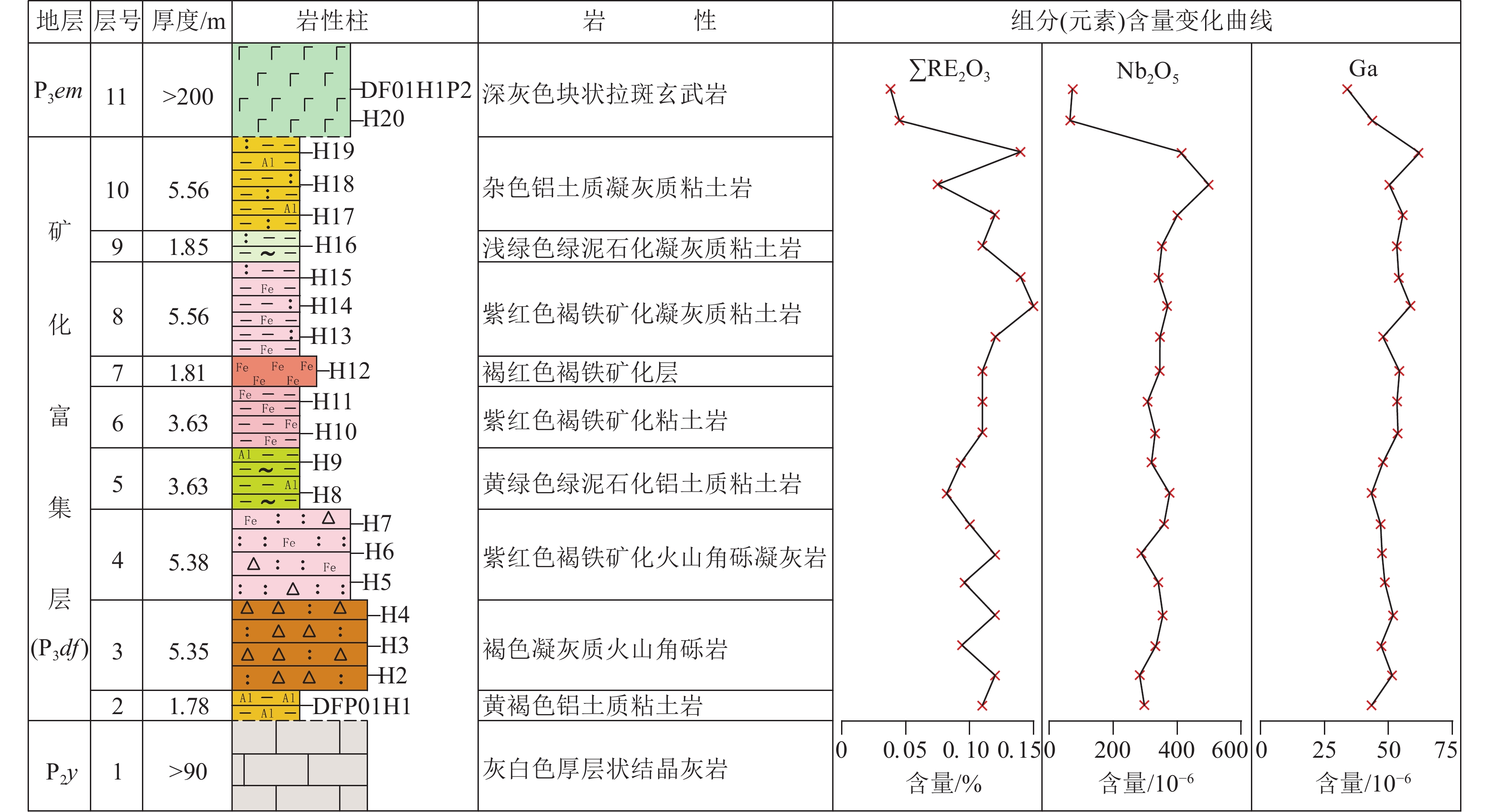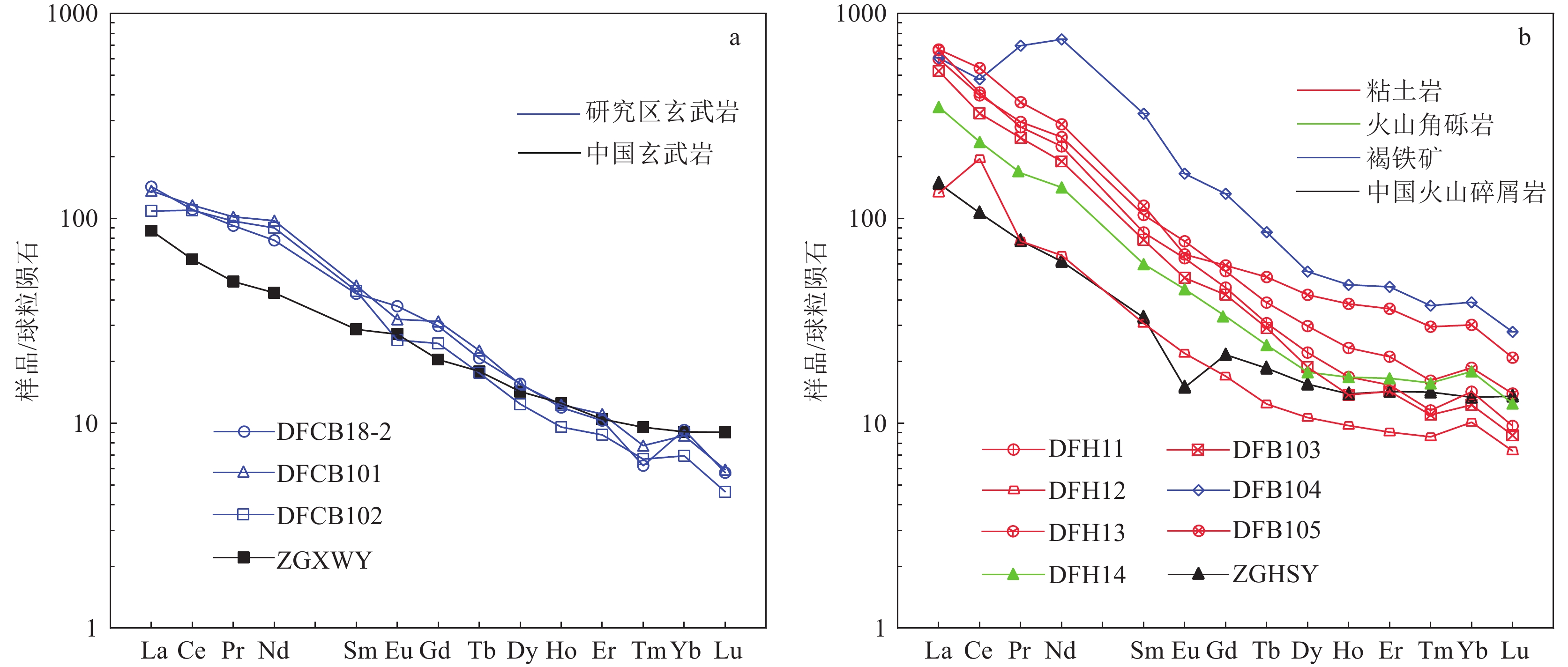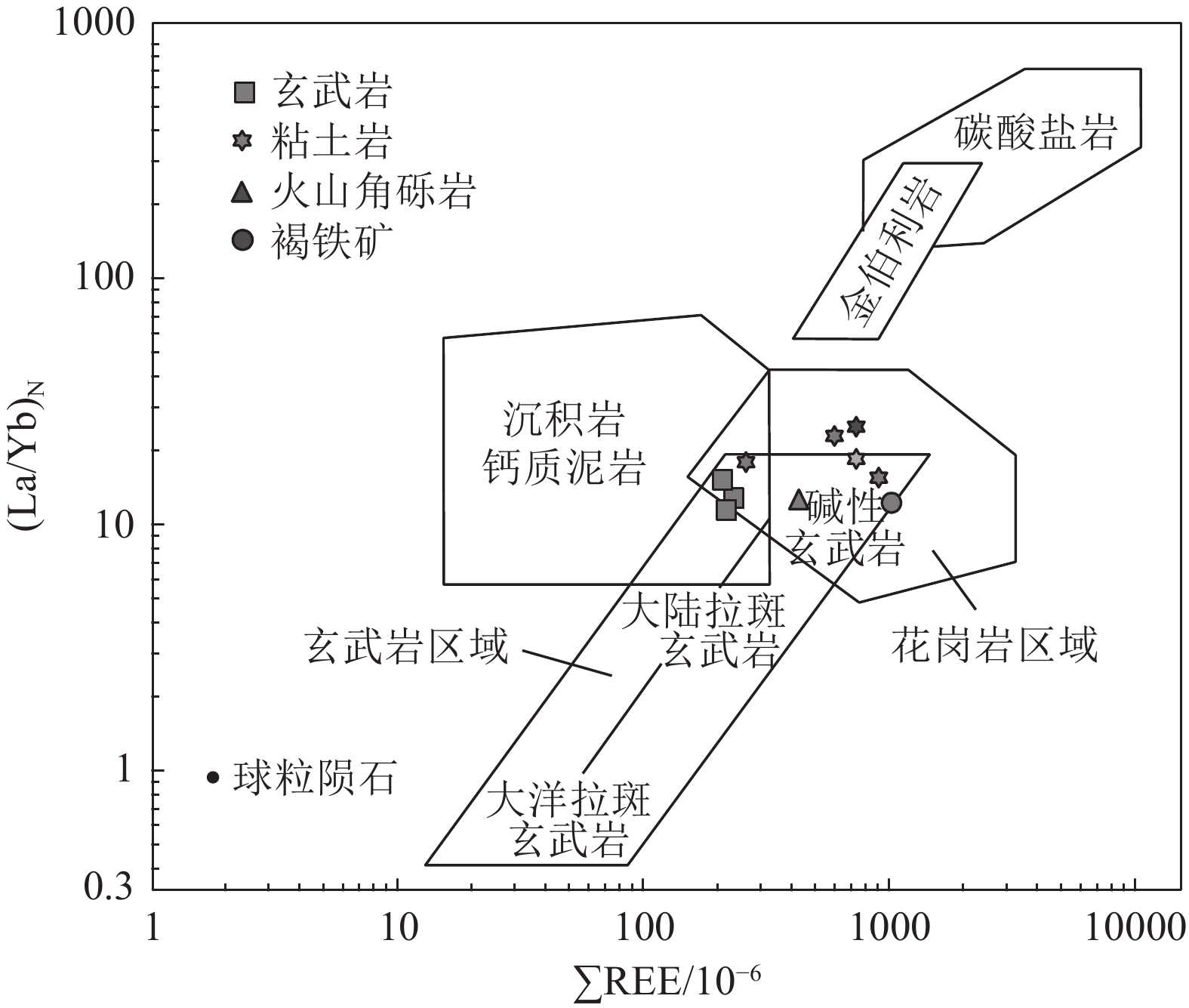Discovery of Ga-Nb-REE enrichment layer at the bottom of Permian Emeishan basalt, Yanbian County, Sichuan Province,and its enlightenment for prospecting and exploration
-
摘要:研究目的
重点对四川省盐边县东风村一带峨眉山玄武岩底部发现的火山沉积型镓-铌-稀土矿化富集层开展岩石学和地球化学研究,分析成矿物源和成矿条件,探讨成矿机制,为找矿勘查提供新的启示。
研究方法在野外调查的基础上,采集具有代表性的岩矿石样品,通过镜下鉴定和主量、微量及稀土元素分析开展研究工作。
研究结果镓−铌−稀土矿化富集层是基性火山碎屑岩强烈风化形成的富铝古风化壳,主要由蚀变凝灰质火山角砾岩、铝土质粘土岩、凝灰质粘土岩等岩石组成,受控于下伏阳新组顶部喀斯特地貌与上覆玄武岩的接触界面。矿化富集层延伸稳定,具有显著的Nb、Ta、Ga、Ti、REE等矿化富集特征且矿化均匀。矿化富集层稀土元素表现为轻稀土元素强烈富集而重稀土元素亏损,Nb、Ta、Ti元素的富集程度随岩石铝质含量增高而变大,Ga元素含量较均匀。成矿物源主要来自峨眉山地幔柱活动形成的玄武岩及基性火山碎屑岩,湿润炎热的古地理环境、平缓开阔的地貌及酸性含氧介质为Ga、Nb、REE等元素的活化、迁移和富集创造了有利条件,成矿元素经历多次溶失、络合、迁移、水解、沉淀和吸附等作用,最终形成矿化富集层。
结论峨眉山玄武岩底部发现的火山沉积型镓−铌−稀土矿化富集层是一种新型的稀有稀土成矿类型,不但具有良好的找矿前景和巨大的资源潜力,而且对研究成矿理论和拓展找矿思路具有重要意义。
-
关键词:
- 镓−铌−稀土矿化富集层 /
- 峨眉山玄武岩 /
- 火山沉积型 /
- 成矿机制 /
- 四川盐边
Abstract:ObjectiveThis paper focus on conducting petrological and geochemical studies on the volcanic-sedimentary Ga-Nb-REE enrichment layer discovered at the bottom of Emeishan basalt in Dongfengcun area, Yanbian County, Sichuan Province, analyzes its ore-forming material sources and metallogenic conditions, discusses its metallogenic mechanism, and provides new enlightenment for prospecting and exploration.
MethodsOn the basis of field investigation, representative rock and ore samples were collected, and the research work was carried out by microscopic identification and analysis of main elements, trace elements and rare earth elements.
ResultsThe Ga-Nb-REE enrichment layer is an aluminum-rich paleo-weathering crust formed by strong weathering of basic volcaniclastic rocks. It is mainly composed of altered tuffaceous volcanic breccia, bauxitic clay rock, tuffaceous clay rock and other rocks. It is controlled by the contact interface between the karst landform at the top of the underlying Yangxin Formation and the overlying basalt. The mineralized enrichment layer extends stably and has significant mineralization enrichment characteristics of niobium, tantalum, gallium, titanium and rare earth element, and the mineralization is uniform. The rare earth elements in the mineralized enrichment layer shows strong enrichment of light rare earth elements and loss of heavy rare earth elements. The enrichment degree of niobium, tantalum and titanium elements increases with the increase of rock aluminum content, and the content of gallium is more uniform. The ore-forming mineral source mainly comes from basalt and basic pyroclastic rocks formed by the activity of Emeishan mantle plume. The humid and hot paleogeographic environment, gentle and open landform and acidic oxygen-containing medium have created favorable conditions for the activation, migration and enrichment of gallium, niobium, rare earth and other elements. The ore-forming elements have undergone multiple dissolution, complexation, migration, hydrolysis, precipitation and adsorption, and finally formed a mineralized enrichment layer.
ConclusionsThe volcanic-sedimentary Ga-Nb-REE enrichment layer found at the bottom of Emeishan basalt is a new metallogenic type of rare and rare earth element.It not only has good prospecting prospects and great resource potential, but also has great significance for studying metallogenic theory and expanding prospecting ideas.
创新点在四川攀西地区峨眉山玄武岩底部首次发现火山沉积型镓-铌-稀土矿化富集层,并对其成矿物源和成矿条件进行分析,探讨成矿机制,为成矿研究和区域找矿勘查提供了依据。
-
铍(Be)是一种关键金属(Freiman, 2008; Foley et al., 2017; 李建康等, 2017),广泛应用于原子能、火箭、导弹、航空航天、冶金等战略性新兴行业(Taylor et al., 2003; Tomberlin, 2004; Snead et al., 2005; Rohe et al., 2011; 王仁财等, 2014; Foley et al., 2017,蒋少涌等,2019;李文昌等,2022)。目前铍资源主要来源于火山岩型铍矿(Lederer et al., 2016),然而随着战略性新兴产业对铍需求的爆发式增长(王伟, 2014; 梁飞等, 2018),铍资源的勘查与找矿已成为中国新一轮找矿突破战略行动的重要任务之一。华南作为中国重要的战略关键金属矿产的主要产区,孕育着大量的稀有金属矿产和非金属矿产(Mao et al., 2013)。东南沿海火山-侵入杂岩发育区的铍矿化强烈,具有良好的铍成矿潜力(饶灿等,2022)。近期,笔者在浙西北常山地区进行了铍矿调查与找矿,取得突破性进展。本文报道了浙西北常山地区铍矿的地质特征和矿物地球化学特征,以期为区域铍资源找矿勘查与指导找矿提供重要支撑。
1. 区域及矿床地质特征
浙西北常山地区位于下扬子岩浆弧常山-桐庐俯冲型火山-侵入岩带,淳安-新登俯冲型火山-侵入岩带南西部,萧山-球川大断裂北西侧。区域内除三叠系、白垩系等缺失外,新元古界—第四系均有出露。区内最古老的地层为新元古界,包括骆家门组、虹赤村组和上墅组,经后期动力变质作用形成了片理化砂岩、片理化泥岩、绿片岩、糜棱岩等;同时出露南华系休宁组浅海相碎屑岩(砾岩、砂砾岩、含砾砂岩、粉砂岩),寒武系海相硅质岩和碳酸盐岩(荷塘组含炭质页岩、灰岩、泥灰岩,大陈岭组白云质灰岩、白云岩,杨柳岗组含炭硅质页岩、泥灰岩,华严寺组条带状灰岩,西阳山组泥灰岩、瘤状灰岩等);奥陶系出露以页岩、砂岩、泥岩为主的台地-盆地相沉积相;志留系、泥盆系、石炭系主要出露浅海—陆相碎屑岩沉积相、滨海—陆源相石英质陆源碎屑沉积相和滨海—浅海相碎屑岩和碳酸盐岩沉积相;侏罗系出露一套较稳定型陆源碎屑沉积相和火山岩(刘道荣等,2012)。
常山地区受晋宁、加里东、华力西、燕山等构造旋回影响,形成以北东向、北北东向为主的构造格架。其基底构造格架控制了本区的沉积建造和地层展布、岩体侵入、火山喷发、中生代构造盆地和各类构造的发育及各类矿产的赋存。区内发育晋宁和燕山旋回火山活动,以喷溢、爆发、间歇性爆发、沉积相间进行,相间出露流纹(斑)岩、火山碎屑岩及火山碎屑沉积岩。岩浆侵入活动以燕山早期和晚期最强,以中酸性侵入岩为主,有少量中基性—酸性岩脉出露。岩性主要为黑云母二长花岗岩、花岗斑岩、辉绿玢岩、闪长玢岩、煌斑岩等。区内发育岩前、芙蓉、大源3个小岩体,属于中浅成岩体,呈岩株和岩枝产出,围岩蚀变较强。出露的矿产主要有钨锡矿、钒矿、银铅锌矿、铍锡矿、煤矿、叶蜡石矿、萤石矿等。
近年来,在常山地区发现了高坞山-蕉坑坞大型萤石矿床(图1)。前人对该地区萤石矿的地质特征、成矿规律及成矿机制进行了详细研究(刘道荣等,2012;古立峰,2013;刘道荣,2013)。目前,2个萤石矿均处于开采状态。该2个矿床位于区内岩前短轴背斜南东翼,受后期构造作用影响,形成一系列断裂和层间破碎带构造。矿区断裂构造发育,呈多期次、多方向展布,走向大致为北东—北东东向、北北东向、北西向和近南北向,其中北东—北东东向、北北东向断裂与萤石成矿关系最密切。岩前岩体是矿区最大的侵入岩,为中细粒黑云母二长花岗岩,其全岩Rb−Sr等时线年龄为124 Ma(韩文彬等,1991)。矿区岩脉发育,岩前岩体北东端和南、北接触带零星出露细粒花岗岩岩脉,高坞山沿北北东走向发育十余条花岗斑岩脉,蕉坑坞也发育少量花岗斑岩脉和辉绿玢岩,而长石岩脉主要分布于萤石矿体周围。在岩前花岗岩周围,热液蚀变强烈,由内向外主要发生矽卡岩化、角岩化、硅化、绢云母化、绿泥石化、萤石化及钾化。前人虽对部分钻孔样品和矿石化学进行过全岩分析,并显示出较高的铍地球化学异常(刘道荣等,2012),但铍的赋存形式和矿化规模尚不清楚。本次通过系统的野外地质调查,结合岩石学、矿物学和地球化学分析,发现高坞山-蕉坑坞大型萤石矿床中出现极高的铍地球化学异常,发育大量铍独立矿物,查明了铍赋存形式,可为常山地区铍矿开采提供理论和技术支持。
![]() 图 1 浙西北高坞山—蕉坑坞地区地质简图 (据刘道荣等,2013修改)Figure 1. Geological map of Gaowushan-Jiaokengwu area in Northwest Zhejiang
图 1 浙西北高坞山—蕉坑坞地区地质简图 (据刘道荣等,2013修改)Figure 1. Geological map of Gaowushan-Jiaokengwu area in Northwest Zhejiang2. 样品与分析方法
本次研究样品采自高坞山-蕉坑坞大型萤石矿体及其围岩。在高坞山萤石矿740 m、695 m、645 m、595 m、545 m、490 m、400 m等不同标高进行样品采集(图2−a);在蕉坑坞萤石矿中,主要采集330 m和290 m标高的萤石围岩样品(图2−b)。对不同标高均进行了系统观察,沿萤石矿体延伸方向,每100 m进行一次系统采样,确保样品具有代表性。全岩主量和微量元素分析在广州澳实分析检测中心完成。研究样品经过烘干破碎至1~2 mm,缩分至250~300 g,然后将样品碾磨至200目。称取3份试样用于主量元素分析:一份用于高氯酸、硝酸、氢氟酸和盐酸消解后蒸干,再用稀盐酸溶解定容制样;一份烘干后,精确称量后置入铂金坩锅,加入四硼酸锂、偏硼酸锂和硝酸锂混合熔剂充分搅拌,再利用熔样机熔融到1050℃后倒入铂金模,冷却制成熔片;另一份精确称重后置入马弗炉进行有氧灼烧至1000℃,冷却后再称重,用于计算样品的烧失量。微量元素分析称取2份试样,分别用于高氯酸、硝酸、氢氟酸消解和加入偏硼酸锂/四硼酸锂熔剂制备样品。全岩的主量元素分析仪器为PANalytical PW2424型X射线荧光光谱仪,其微量和稀土元素分析仪器分别为Agilent 5100和7900 电感耦合等离子体发射光谱与质谱,测试误差均在10%以内。
![]() 图 2 高坞山萤石矿矿体剖面图(a)和蕉坑坞萤石矿矿体剖面图(b) (据刘道荣等,2013修改;其中星号为采样点)Q—第四系;O1y—下奥陶统印渚埠组;∈3x—上寒武统西阳山组;∈3h—上寒武统华严寺组;∈2y—中寒武统杨柳岗组Figure 2. Profile of Gaowushan fluorite deposit(a) and Jiaokengwu fluorite deposit (b)
图 2 高坞山萤石矿矿体剖面图(a)和蕉坑坞萤石矿矿体剖面图(b) (据刘道荣等,2013修改;其中星号为采样点)Q—第四系;O1y—下奥陶统印渚埠组;∈3x—上寒武统西阳山组;∈3h—上寒武统华严寺组;∈2y—中寒武统杨柳岗组Figure 2. Profile of Gaowushan fluorite deposit(a) and Jiaokengwu fluorite deposit (b)铍矿物的原位定量化学成分分析在浙江大学地球科学学院电子探针实验室完成,电子探针型号为EPMA-1720H。定量分析条件为:电压12 kV、硅铍石和羟硅铍石的分析电流分别为200 nA和50 nA,束斑为1μm,Be元素的特征峰测试时间为100 s,背景测试时间为50 s,其他元素特征峰测试时间为20 s,背景测试时间为10 s。硅铍石和羟硅铍石的电子探针分析标样为:福建南平伟晶岩硅铍石(SiKα、BeKα)、硅锌矿 (MnKα)、钾长石(AlKα和KKα)、斜长石(NaKα)、铁铝榴石(CaKα和FeKα)、镁铝榴石(MgKα),所有数据均进行了ZAF3处理。
3. 铍矿化特征
高坞山-蕉坑坞大型萤石矿床产于花岗岩体与围岩接触面及其附近外接触带、花岗岩围岩的层间破碎带及构造破碎带。与花岗岩接触部位,矽卡岩化较强烈,围岩出现各种热液蚀变现象,如角岩化、硅化、大理岩化、绢云母化、绿泥石化、萤石矿化、钾长石化等。花岗岩围岩主要为寒武系华严寺组和杨柳岗组灰岩;层间破碎带分布于华严寺组和西阳山组灰岩中;构造破碎带通常垂直或斜向切穿杨柳岗组、华严寺组和西阳山组。萤石矿体主要受构造控制,多赋存于北北东向构造带中,矿体走向最长450 m,最大倾斜延深约550 m。在高坞山和蕉坑坞萤石矿深部均可见花岗岩(图3−a),花岗岩的围岩绝大部分已经蚀变,形成层状和似层状蚀变岩,但仍保留灰岩的条带结构(图3−b~d),同时可见花岗斑岩(图3−e),受构造断裂作用,大量萤石脉和方解石脉穿插于蚀变灰岩中(图3−f, g)。
通过对高坞山和蕉坑坞萤石矿矿区进行野外考察,采集不同标高不同蚀变类型的萤石矿体围岩样品。样品的全岩及Be化学全分析结果表明(表1),铍矿化主要发育于萤石矿体与围岩的接触带,不同标高(740 m、695 m、645 m、595 m、545 m、490 m、400 m)萤石矿体围岩均有不同程度Be富集。高坞山萤石矿区Be含量达4400×10−6,而蕉坑坞萤石矿区为1300×10−6。
表 1 浙西北高坞山和蕉坑坞萤石矿围岩主量元素及Be含量Table 1. The whole rock major elements and beryllium content of host rocks of Gaowushan and Jiaokengwu fluorite deposit in Northwest Zhejiang Province样品号 SiO2 Al2O3 CaO TFe2O3 MgO MnO BaO K2O Na2O P2O5 SnO2 SO3 TiO2 F 烧失量 Be/10−6 GWS 740-1 57.62 11.88 10.65 2.67 1.75 0.04 0.10 6.99 0.99 0.04 <0.01 <0.01 0.33 6.2 4.35 305 GWS 740-2 55.67 10.52 13.90 2.28 1.82 0.03 0.09 5.70 0.06 0.07 0.01 0.04 0.28 6.2 6.77 550 GWS 740-3 42.29 12.33 21.1 2.51 2.23 0.04 0.05 5.52 2.29 0.03 0.02 <0.01 0.40 12.9 4.06 148.5 GWS 740-4 52.44 9.47 14.80 3.12 3.93 0.07 <0.01 5.02 0.75 <0.01 0.01 0.05 0.22 8.0 6.43 31.8 GWS 740-5 37.13 10.62 28.7 2.08 1.85 0.03 0.02 2.36 3.50 0.01 0.02 <0.01 0.21 17.2 4.45 146.0 GWS 695 35.38 10.26 23.0 4.19 4.10 0.09 0.16 4.65 0.48 0.07 0.01 0.09 0.40 5.5 14.52 117.5 GWS 645-1 43.21 11.77 21.8 1.34 1.22 0.04 0.06 9.28 0.13 <0.01 0.02 <0.01 0.05 13.2 4.22 4400 GWS 645-2 71.10 14.42 0.17 0.63 0.97 0.02 0.22 9.97 0.09 0.01 <0.01 <0.01 0.11 0.1 1.43 1100 GWS 645-3 34.02 10.74 28.2 3.32 2.42 0.06 0.05 6.48 0.10 0.01 0.03 0.93 0.19 16.5 5.40 589 GWS 595-1 71.89 14.50 0.48 1.78 0.03 0.08 0.01 4.84 4.32 <0.01 <0.01 0.08 0.01 0.8 0.97 18.60 GWS 545-1 12.90 3.81 56.5 0.57 1.40 0.02 0.06 2.25 0.07 <0.01 0.05 0.01 0.05 33.7 2.54 85.8 GWS 545-2 16.40 6.96 45.0 1.86 6.32 0.05 0.15 2.58 0.07 0.07 0.05 0.02 0.28 27.9 3.94 1300 GWS 490-2 73.74 12.14 0.85 2.52 0.09 0.03 0.01 5.62 2.90 0.01 <0.01 0.03 0.17 0.4 1.01 19.60 GWS 400-1 9.81 2.65 43.2 1.15 5.92 0.04 0.07 1.44 0.03 0.01 0.02 0.39 0.10 0.6 35.42 15.75 JKW 330-3 28.47 7.46 25.9 22.98 4.82 0.46 0.05 1.16 0.68 0.07 0.23 0.04 0.05 8.6 3.07 168.0 JKW-1 20.47 2.54 53.2 0.61 0.70 0.01 0.04 1.69 0.05 0.02 0.04 <0.01 0.01 31.8 2.90 73.5 JKW-3 26.06 4.70 43.9 1.09 2.92 0.02 0.05 3.73 0.05 0.01 0.03 <0.01 0.08 25.7 3.19 1300 注:主量元素含量单位为% 室内显微镜观察与电子探针分析结果表明,高坞山和蕉坑坞萤石矿中铍矿物主要为硅铍石和羟硅铍石,它们常与萤石、钾长石、石英、方解石等矿物形成矿物组合(图版Ⅰ)。硅铍石晶体大小可达到厘米级。较大的硅铍石晶体通常晶形较好(图版Ⅰ−a,b),少量硅铍石包裹于萤石中,部分已转变为羟硅铍石(图版Ⅰ−c)。硅铍石常与钾长石、萤石、方解石形成矿物组合(图版Ⅰ−d),少量大颗粒硅铍石晶体与钾长石紧密共生(图版Ⅰ−e)。在以钾长石为主的矿物裂隙中,可见硅铍石与萤石形成的细脉(图版Ⅰ−f),也可见钾长石与硅铍石、方解石形成的细脉(图版Ⅰ−g)。羟硅铍石主要分布于钾长石与石英、萤石晶间(图版Ⅰ−h),少量羟硅铍石分布于钾长石裂隙中,其形成与钾长石的热液蚀变有关(图版Ⅰ−i)。电子探针化学成分分析结果表明,高坞山与蕉坑坞萤石矿中,硅铍石和羟硅铍石的化学成分均相似,硅铍石含53.69% ~ 56.52% SiO2,42.45% ~ 46.12% BeO,同时还含少量MnO、MgO、Al2O3、FeO等,其含量不超过0.5%;羟硅铍石含48.79% ~ 53.46% SiO2、40.13% ~ 43.93% BeO,Al2O3含量最高可达0.45%,同时含少量MnO、MgO、FeO等,不含F或F含量低于检测限。
4. 矿床成因与发现意义
Be在流体中表现为双性元素的地球化学行为,在酸性流体或热液中,Be以阳离子形式存在,在碱性流体或热液中,Be常与碱金属或碱土金属元素结合,以络阴离子形式存在(Černý, 2002)。鉴于此,Be在岩浆-热液过程中均可以得到富集甚至成矿,在变质作用过程中也可得到超常富集。在岩浆-热液过程中Be得到超常富集,可以形成火山岩型铍矿、花岗岩型铍矿、伟晶岩型铍矿、碱性岩型铍矿、矽卡岩型铍矿等(Barton et al., 2002)。目前,火山岩型铍矿是国际铍资源的主要来源(Lederer et al., 2016),其成矿机制主要为含Be凝灰岩或流纹岩经过热液蚀变,Be获得超常富集并成矿(Wood, 1992; Foley et al., 2012),羟硅铍石和硅铍石是火山岩型铍矿主要的矿石矿物(Lederer et al., 2016; Foley et al., 2017)。
花岗斑岩、花岗岩等侵入岩在形成和演化过程中,与碳酸盐岩围岩反应通常会形成一系列蚀变岩或矽卡岩。这些接触变质或热液蚀变过程也会导致Be富集成矿(Barton et al., 2002),如在湘南地区香花岭矽卡岩(黄蕴慧等,1988;赵一鸣等,2017)、香花铺矽卡岩、界牌岭矽卡岩(唐朝永等,2010)中,Be均得到不同程度地富集,形成硅铍石、羟硅铍石、锂铍石、香花石、孟宪民石等铍矿物。俄罗斯西部Transbaikalia地区也发育典型的矽卡岩型铍矿床(Lykhin et al., 2014; Damdinova et al., 2019)。然而,矽卡岩型铍矿床极少作为铍矿开采。
与典型矽卡岩型铍矿相比,高坞山和蕉坑坞铍矿具有如下显著特征:①矿山正在进行萤石矿开采,极易弄清楚铍矿的分布;②矽卡岩化较弱,符山石、钙铝榴石等矽卡岩矿物占比较小,更多出现角岩化、硅化、绿泥石化和萤石化;③铍矿分布在萤石矿体与围岩接触带,Be的超常富集与萤石化、钾长石化、碳酸盐化相关;④铍矿石矿物为硅铍石和羟硅铍石(图版Ⅰ),铍矿物种较单一,未出现矽卡岩型铍矿中复杂且铍矿物种较多的情况。该矿床受岩前岩体岩浆侵入作用、构造活动及碳酸盐岩地层控制,岩体侵位过程中高F热液作用是Be超常富集的核心控制因素。刘道荣(2013) 认为,高坞山-蕉坑坞萤石矿属于中低温热液矿床,受岩前岩体、构造、地层3个因素共同控制,成矿作用以充填为主,伴有交代作用。但常山地区的萤石矿又与传统花岗岩周围萤石矿有一定区别,出现了较弱的矽卡岩化。同样,高坞山和蕉坑坞地区Be的富集也与花岗岩和围岩相关,Be的富集是岩前花岗岩岩浆和热液与围岩发生反应所致,属于热液型铍矿床。地球化学分析结果表明,岩前黑云母二长花岗岩含17×10−6 Be,周围的花岗斑岩脉含Be 15×10−6,而煌斑岩岩脉Be的含量达115×10−6 (郑兴泉等,1990;古立峰,2013)。常山地区泥质灰岩可含40×10−6 Be,黄铁矿化角岩可含105×10−6 Be (李良传等,2017)。高坞山和蕉坑坞萤石矿具有强烈的铍矿化,部分矿化点可达4400×10−6 和1300×10−6 Be (表1),萤石矿石可含390×10−6 Be (刘道荣等,2012;刘道荣,2013)。这些特征显示,高坞山和蕉坑坞地区铍成矿潜力巨大,具有丰富的铍资源。
鉴于正在开采的高坞山和蕉坑坞大型萤石矿床中发现了铍矿化,将有助于矿山综合利用,合理开发萤石资源和铍资源。硅铍石和羟硅铍石作为铍矿石矿物,更有利于选冶。除高坞山和蕉坑坞外,在常山地区毛良坞—姜家、蚵蚾坞、严家—瑶岭、八面山—丁家与修书一带均发现了Be的土壤地球化学异常(李良传等,2017)。这些特征显示,常山地区具有较大的铍资源潜力,在今后勘查和找矿过程中应予以格外重视。
-
图 1 东风村地区大地构造位置(a,据罗改等,2021修改)、地质简图(b,据左群超等,2006修改)及实测地质剖面简图(c)
T3bg—白果湾组;P3em—峨眉山玄武岩;P3df—"东风层"(Ga−Nb−REE含矿层);P2y—阳新组;D2-3—中上泥盆统;S1-2—中下志盆统;O1-2—中下奥陶统;∈1c—沧浪铺组;Z∈d—灯影组;Z1g—观音崖组;Nh3lg—列古六组;Pt2H—会理群;PM1—实测剖面编号;①—龙门山-小金河断裂;②—金河-程海断裂;③—磨盘山-绿汁江断裂;④—鲜水河-安宁河断裂;⑤—甘洛-小江断裂;⑥—攀枝花-楚雄断裂;剖面岩性:1—灰岩;2—铝土质粘土岩;3—凝灰质火山角砾岩;4—褐铁矿化火山角砾凝灰岩;5—绿泥石化铝土质粘土岩;6—褐铁矿化粘土岩;7—褐铁矿化层;8—铁质凝灰质粘土岩;9—绿泥石化凝灰质粘土岩;10—铝土质凝灰质粘土岩;11—玄武岩
Figure 1. Geotectonic location map(a), geological sketch map (b), and measured geological section (c) of Dongfengcun area
图 3 东风村地区火山岩原始地幔标准化多元素配分图(标准化数值据Sun et al., 1989;Ga标准化数值据Taylor et al., 1985)
a—玄武岩;b—矿化富集层岩石
Figure 3. Primitive mantle-standardized multi-element variation diagrams of volcanic rocks in Dongfengcun area
图 2 含矿岩系剖面柱状图和成矿元素含量变化曲线图(地层代号注释同图1)
Figure 2. Section histogram of ore-bearing rock series and ariation curve of ore-forming element contents
图 4 东风村地区火山岩球粒陨石标准化稀土元素配分图(标准化数值据Boynton,1984)
a—玄武岩;b—矿化富集层岩石
Figure 4. Chondrite-normalized REE variation diagrams of volcanic rocks in Dongfengcun area
图 5 东风村地区火山岩∑REE−(La/Yb)N图解(底图据Allegre et al., 1978)
Figure 5. Diagram of ∑REE−(La/Yb)N of volcanic rocks in Dongfengcun area
表 1 含矿岩系简项分析结果
Table 1 Abbreviated analysis results of ore-bearing rock series
样品号 ΣRE2O3/% Nb2O5/10−6 Ta2O5/10−6 (Nb,Ta)2O5/10−6 Ga/10−6 TiO2/% DFCP01H1 0.11 298.69 19.01 317.70 43.17 3.18 DFCP01H2 0.12 284.10 18.10 302.19 51.33 3.68 DFCP01H3 0.09 335.60 21.06 356.65 46.93 3.87 DFCP01H4 0.12 357.05 22.63 379.68 51.68 4.04 DFCP01H5 0.10 341.60 21.56 363.17 48.50 3.95 DFCP01H6 0.12 288.96 18.85 307.81 47.41 3.32 DFCP01H7 0.10 359.91 23.30 383.21 46.76 4.34 DFCP01H8 0.08 377.87 23.63 401.50 43.17 4.36 DFCP01H9 0.09 320.58 20.55 341.13 47.60 3.64 DFCP01H10 0.11 332.59 21.39 353.98 53.64 3.55 DFCP01H11 0.11 308.56 20.29 328.85 53.16 3.38 DFCP01H12 0.11 346.61 22.32 368.93 54.21 3.88 DFCP01H13 0.12 347.40 22.16 369.55 47.84 3.83 DFCP01H14 0.15 371.79 24.87 396.66 58.38 4.90 DFCP01H15 0.14 343.03 22.69 365.72 53.93 4.74 DFCP01H16 0.11 354.33 22.87 377.21 53.06 4.55 DFCP01H17 0.12 403.26 26.27 429.52 55.54 5.30 DFCP01H18 0.08 501.18 31.16 532.34 50.31 6.16 DFCP01H19 0.14 409.55 25.86 435.42 62.06 5.39 DFCP01H20* 0.045 65.90 4.59 70.49 43.52 2.80 DFCP01H21* 0.038 73.48 4.52 78.00 33.81 2.68 平均值 0.11 351.72 22.56 374.28 50.98 4.21 变化系数/% 17.23 14.14 13.47 14.09 9.60 18.84 富集系数 6.76 12.94 11.57 12.84 2.83 3.94 注:*为玄武岩样;平均值、变化系数、富集系数为矿化富集层样品计算值;富集系数=组分(元素)含量/地壳丰度,地壳丰度值据黎彤(1976) 表 2 含矿岩系主量、微量和稀土元素含量及特征参数
Table 2 Contents and characteristic parameters of major, trace and rare earth elements for ore−bearing rock series
元素 DFH11 DFH12 DFH13 DFH14 DFB103 DFB104 DFB105 DFB18−2 DFB101 DFB102 紫红色粘土岩 黄绿色粘土岩 紫红色凝灰岩 火山角砾岩 黄褐色粘土岩 红褐色褐铁矿 杂色粘土岩 玄武岩 玄武岩 玄武岩 SiO2 33.68 12.03 31.89 30.32 28.58 13.15 19.76 48.41 48.04 46.95 TiO2 4.18 6.86 4.96 4.62 6.38 1.07 3.22 2.87 2.30 2.24 Al2O3 29.42 41.19 28.28 29.92 46.71 9.54 15.61 13.19 11.23 10.99 Fe2O3 19.50 10.23 19.98 20.45 1.99 63.67 39.98 4.75 4.44 4.18 FeO 0.46 15.65 0.53 0.21 1.22 3.39 8.75 6.81 7.15 7.46 MnO 0.01 0.01 0.02 0.00 0.00 0.07 0.02 0.18 0.17 0.18 MgO 0.12 0.83 0.19 0.15 0.22 1.27 1.35 6.03 9.56 10.88 CaO 0.20 0.06 0.33 0.10 0.18 0.31 0.47 8.36 9.21 9.60 Na2O 0.04 0.02 0.03 0.03 0.06 0.05 0.03 3.59 2.07 1.63 K2O 0.06 0.01 0.05 0.04 0.05 0.04 0.09 1.23 1.67 1.60 P2O5 0.19 0.06 0.25 0.10 0.15 0.22 0.19 0.36 0.30 0.30 烧失量 11.67 9.69 12.39 13.27 13.62 7.51 9.65 — 3.23 3.61 总计 99.53 96.65 98.90 99.23 99.17 100.28 99.12 — 99.35 99.61 CIA 99.31 99.85 99.49 99.53 99.47 98.01 98.82 50.09 56.64 60.82 CIW 99.54 99.87 99.68 99.69 99.58 98.46 99.42 52.76 62.31 67.27 ICV 0.63 0.43 0.72 0.66 0.22 4.82 2.18 3.38 4.64 5.02 Ki 1.95 0.50 1.92 1.72 1.04 2.34 2.15 6.24 7.27 7.26 La 205.46 41.19 186.23 108.57 162.46 188.25 207.07 44.28 42.31 33.70 Ce 332.88 158.15 322.53 191.10 263.10 386.34 438.25 89.30 93.70 88.57 Pr 34.08 9.45 36.10 20.34 30.17 85.12 45.07 11.24 12.43 11.84 Nd 134.95 39.61 149.82 85.08 113.92 449.36 172.93 46.89 58.47 53.95 Sm 16.66 6.00 20.28 11.68 15.31 63.29 22.50 8.36 9.16 8.64 Eu 4.70 1.61 5.69 3.32 3.77 12.17 4.91 2.74 2.37 1.87 Gd 11.90 4.40 14.33 8.62 10.98 34.18 15.28 7.72 8.14 6.35 Tb 1.46 0.59 1.84 1.14 1.39 4.06 2.45 0.98 1.07 0.83 Dy 7.13 3.44 9.61 5.73 6.05 17.73 13.65 5.02 4.98 3.99 Ho 1.21 0.70 1.67 1.21 0.99 3.41 2.75 0.86 0.88 0.69 Er 3.23 1.90 4.44 3.49 3.00 9.74 7.62 2.16 2.33 1.84 Tm 0.37 0.28 0.52 0.51 0.36 1.22 0.96 0.20 0.25 0.22 Yb 2.98 2.11 3.90 3.74 2.57 8.15 6.32 1.94 1.82 1.45 Lu 0.32 0.24 0.46 0.41 0.29 0.93 0.69 0.19 0.20 0.15 Y 28.18 17.25 38.17 25.30 22.80 124.29 95.65 22.84 23.97 17.32 LREE 728.73 256.01 720.65 420.09 588.74 1184.52 890.73 202.81 218.44 198.57 HREE 56.80 30.92 74.96 50.15 48.43 203.70 145.37 41.92 43.64 32.85 ∑REE 785.53 286.93 795.61 470.24 637.17 1388.22 1036.11 244.73 262.08 231.42 ∑Ce/∑Y 12.83 8.28 9.61 8.38 12.16 5.81 6.13 4.84 5.01 6.04 δEu 0.97 0.92 0.97 0.97 0.85 0.73 0.77 1.03 0.82 0.74 δCe 0.96 1.93 0.95 0.98 0.90 0.73 1.09 0.96 0.98 1.07 (La/Yb)N 46.47 13.13 32.18 19.55 42.62 15.57 22.09 15.41 15.68 15.68 (La/Sm)N 7.76 4.32 5.78 5.85 6.67 1.87 5.79 3.33 2.90 2.45 (Gd/Yb)N 3.22 1.68 2.96 1.86 3.45 3.38 1.95 3.22 3.61 3.54 Rb 3.36 0.69 2.09 1.43 2.52 12.27 12.63 10.44 43.00 39.74 Ba 211.30 48.94 278.25 102.49 174.04 140.13 222.73 702.80 433.17 434.16 Th 32.34 30.07 22.96 18.30 44.66 10.11 24.28 3.28 4.96 2.53 U 9.26 15.87 8.43 8.11 17.84 5.63 8.88 1.15 1.02 0.56 Nb 285.09 414.28 291.87 268.88 442.31 78.24 250.47 37.13 45.89 39.39 Ta 17.25 23.83 19.73 17.03 21.16 3.98 12.52 3.47 2.56 2.47 Sr 316.56 106.75 353.86 189.48 247.84 139.65 292.17 485.10 551.10 506.49 Zr 729.78 1128.20 705.98 695.21 1093.08 203.93 627.87 258.30 273.25 249.58 Hf 16.46 23.73 15.90 15.71 30.95 2.86 11.62 6.40 6.99 6.53 Bi 0.17 0.34 0.25 0.25 0.52 0.33 0.43 0.07 0.07 0.08 Ga 46.67 57.67 46.17 45.60 53.64 54.21 50.31 32.85 43.52 33.81 Co 31.18 50.92 35.47 31.00 9.45 385.31 59.44 48.72 59.57 46.25 Cr 133.93 196.54 198.49 145.71 159.79 119.73 189.92 176.64 648.57 472.28 Cs — — — — 0.66 1.40 1.75 0.16 0.51 0.65 Ni 32.29 18.70 56.41 45.16 33.38 62.82 37.45 64.53 162.23 132.33 Sc 13.12 15.38 16.34 11.22 21.06 18.15 18.25 22.79 31.40 36.34 Sn 5.33 7.99 5.93 5.65 8.99 3.55 6.34 1.77 3.59 3.82 V 551.65 586.40 476.25 349.45 588.45 280.32 854.39 344.56 340.89 253.39 W — — — — 3.73 1.82 5.07 6.41 0.62 0.57 Li 253.65 134.20 228.90 268.35 439.44 59.02 97.08 — 8.69 10.01 Pb 26.06 19.12 23.98 30.69 29.56 14.55 27.27 — 7.44 9.87 Zn 108.69 160.38 114.83 105.87 31.03 233.05 107.47 — 103.40 107.10 Cu 38.10 18.90 69.80 78.70 75.25 44.03 50.98 — 166.95 134.54 Nb/Ta 16.53 17.39 14.79 15.79 20.90 19.66 20.01 10.69 17.95 15.93 Th/Ta 1.87 1.26 1.16 1.07 2.11 2.54 1.94 0.94 1.94 1.02 Zr/Hf 44.34 47.54 44.40 44.25 35.32 71.30 54.03 40.36 39.09 38.25 La/Th 6.35 1.37 8.11 5.93 3.64 18.62 8.53 13.51 8.53 13.32 Ti/Nb 87.87 99.29 101.86 103.07 86.43 81.98 77.05 463.43 299.97 340.89 Sr/Ba 1.50 2.18 1.27 1.85 1.42 1.00 1.31 0.69 1.27 1.17 Sr/Cu 8.31 5.65 5.07 2.41 3.29 3.17 5.73 — 3.30 3.76 U/Th 0.29 0.53 0.37 0.44 0.40 0.56 0.37 0.35 0.21 0.22 Ni/Co 1.04 0.37 1.59 1.46 3.53 0.16 0.63 1.32 2.72 2.86 注:①稀土元素参数采用球粒陨石标准化值(Boynton,1984)。②CIA=Al2O3×100/(Al2O3+CaO*+Na2O+K2O);CIW=Al2O3/(Al2O3+CaO*+Na2O);WIP=100×(2Na2O/0.35+MgO/0.9+2K2O/0.25+CaO*/0.7);ICV=(Fe2O3+K2O+Na2O+CaO+MgO+TiO2)/Al2O3;Ki=SiO2/Al2O3;CaO*为硅酸盐中CaO的摩尔含量,即若CaO<Na2O,采用CaO作为样品CaO*,相反则采用Na2O作为CaO*(McLennan,1993);各式中氧化物均为摩尔含量。主量元素含量单位为%,微量和稀土元素含量单位为10−6 -
Allegre C J, Minster J F. 1978. Quantitative models of trace element behavior in magmatic processes[J]. Earth and Planetary Science Letters, 38(1): 1−25. doi: 10.1016/0012-821X(78)90123-1
Boynton W V. 1984. Geochemistry of the rare earth elements: meteorite studies[C]//Henderson P. Rare earth element geochemistry. Elsevier: 63−114.
Cao H S. 1991. A discussion on the genetic environment and minerogenesis of "Dachang Strata"in southwestern Guizhom[J]. Geology of Guizhou, 8(1): 5−12 (in Chinese with English abstract).
Chen Y, Liu X C, Zhang Q H. 1984. A tentative discussion on the genesis of the Dchang antimony deposit, Qinglong County, Guizhou Province[J]. Mineral Deposits, 3(8): 1−12 (in Chinese with English abstract).
Chen Z, Hou L Y, Mo Z. 2015. Discovery of niobium mineralization body and its significance in Yulong, Weining, Guizhou[J]. Guizhou Geology, 32(3): 177−180 (in Chinese with English abstract).
Chung S L, Jahn B M. 1995. Plume−lithosphere interaction in generation of the Emeishan flood basalts at the Permian−Triassic boundary[J]. Geology, 23(10): 559−892.
Deng P, Chen Y M, Ye J H, et al. 2019. Study on the resource distribution and industry development of global niobium and tantalum[J]. China Miming Magazine, 28(4): 63−68 (in Chinese with English abstract).
Du L J, Chen J, Yang R D, et al. 2020. Hydrothermal—volcanic sedimentary and mineralization of the Dachang layer in the Middle−Late Permian, Qinglong, southwestern Guizhou[J]. Geological Review, 66(2): 439−456 (in Chinese with English abstract).
Fan Y H, Qu H J, Wang H, et al. 2012. The application of trace elements analysis to identifying sedimentary media environment: A case study of Late Triassic strata in the middle part of western Ordos Basin[J]. Geology in China, 39(2): 382−389 (in Chinese with English abstract).
Fedo C M, Nesbitt H W, Young G M. 1995. Unraveling the effects of potassium metasomatism in sedimentary rocks and paleosols, with implications for weathering conditions and provenance[J]. Geology, 23: 921−924.
Gun M S, Cai G S, Zeng D G, et al. 2021. Discovery and significance of the Sc−Nb−REE−enriched zone in the paleocrust of weathering atop the Permian Emeishan basalt in western Guizhou Province[J]. Acta Mineralogica Sinica, 41: 1−18 (in Chinese with English abstract).
He B, Xu Y G, Huang X L, et al. 2007. Age and duration of the Emeishan flood volcanism, SW China: Geochemistry and SHRIMP zircon U–Pb dating of silicic ignimbrites, post−volcanic Xuanwei Formation and clay tuff at the Chaotian section[J]. Earth and Planetary Science Letters, 255: 306−323. doi: 10.1016/j.jpgl.2006.12.021
He B, Xu Y G, Xina L, et al. 2003a. Does the Panzhihua−Xichang rift exist?[J]. Geological Review, 49(6): 572−582 (in Chinese with English abstract).
He B, Xu Y G, Xiao L, et al. 2003b. Generation and spatial distribution of the Emeishan large igneous province : New evidence from stratigraphic records[J]. Acta Geologica Sinica, 77(2): 194−202 (in Chinese with English abstract).
He B, Xu Y G, Xiao L, et al. 2006. Sedimentary responses to uplift of Emeishan mantle plume and its implications[J]. Geological Review, 52(1): 30−37 (in Chinese with English abstract).
He, H Y, He M, Li J W. 2018. Analysis of the niobium resources supply and demand pattern in China[J]. China Miming Magazine, 27(11): 1−5 (in Chinese with English abstract).
Hou Z Q, Chen J, Zhai M G. 2020. Current status and frontiers of research on critical mineral resources[J]. Chinese Science Bulletin, 65(33): 1−2 (in Chinese with English abstract).
Hou Z Q, Lu J R, Wang Y L, et al. 1999. Emei large igneous province: Characteristics and origin[J]. Geological Review, 45(sup.): 885−891 (in Chinese with English abstract).
Hu R Z, Tao Y, Zhong H, et al. 2005. Mineralization systems of a mantle plume: A case study from the Emeishan igneous province, southwest China[J]. Earth Science Frontiers, 12(1): 42−54 (in Chinese with English abstract).
Huang X H. 1997. The Lufang rare earth deposit in Eeining, western Guizhou and its mineralization[J]. Guizhou Geology, 14(4): 328−333 (in Chinese with English abstract).
Ji H L, He Z B, Wei S Y, et al. 2022. Geochemical characteristics of trace elements and its sedimentary implication in Baoquanling Formation, Tangyuan fault depression[J]. World Nuclear Geoscience, 39(1): 27−38 (in Chinese with English abstract).
Li H B, Zhu J. 2013. Contact between the Emeishan basalt and Maokou Formation: Implication for the geodynamic model of the Emeishan mantle plume[J]. Geotectonica et Metallogenian, 37(4): 571−579 (in Chinese with English abstract).
Li H B, Zhang Z C, Lyü L S. 2010. Geometry of the mafic dyke swarms in Emeishan large igneous province: Implications for mantle plume[J]. Acta Mineralogica Sinica, 26(10): 3143−3152 (in Chinese with English abstract).
Li H B, Zhang Z C, Lü L S, et al. 2011. Isopach maps of the Qixia and Maokou formations: Implication for mantle plume model of the Emeishan large igneous province[J]. Acta Mineralogica Sinica, 27(10): 2963−2974 (in Chinese with English abstract).
Li H B, Zhang Z C, Santosh M, et al. 2017. Late Permian basalts in the Yanghe area, eastern Sichuan Province, SW China: Implications for the geodynamics of the Emeishan flood basalt province and Permian global mass extinction[J]. Journal of Asian Earth Sciences, 134: 293−308. doi: 10.1016/j.jseaes.2016.11.029
Li J K, Li P, Wang D H, et al. 2019. A review of niobium and tantalum metallogenic regularity in China[J]. Chinese Science Bulletin, 64(15): 1545−1566 (in Chinese with English abstract). doi: 10.1360/N972018-00933
Li X L, Zhang X, Lin C M, et al. 2022. Overview of the application and prospect of common chemical weathering indices[J]. Geological Journal of Chian Universities, 28(1): 51−63 (in Chinese with English abstract).
Li Z M. 2018. Discovery and significance of Huangnipo niobium deposit in Weining of Guizhou[J]. Nonferrous Metals Design, 45(4): 72−74 (in Chinese with English abstract).
Liu D R. 2020. Nb and REE deposits found in the weathering crusts of Emeishan basalt, Xuanwei area, Yunnan Province[J]. Geology in China, 47(2): 540−541 (in Chinese with English abstract).
Liu R, Luo B, Li Y, et al. 2021. Relationship between Permian volcanic rocks distribution and karst paleogeomorphology of Maokou Formation and its significance for petroleum exploration in western Sichuan Basin, SW China[J]. Petroleum Exploration and Development, 48(03): 575−585 (in Chinese with English abstract).
Luo G, Wang Q W, Qin Y L, et al. 2021. Divisions and their basic characteristics of tectonic units in Sichuan Province[J]. Sedimentary Geology and Tethyan Geology, 41(4): 633−647 (in Chinese with English abstract).
Luo Z L, Jin Y Z, Zhu K Y, et al. 1998. On Emei taphrogenesis of the Upper Yangtze platform[J]. Geological Review, 34(1): 11−24 (in Chinese with English abstract).
Mao G Z, Liu C Y. 2011. Application of geochemistry in provenance and depositional setting analysis[J]. Journal of Earth Sciences and Environment, 33(4): 337−348 (in Chinese with English abstract).
Mclennan S M. 1993. Weathering and global denudation[J]. The Journal of Geology, 101(2): 295−303. doi: 10.1086/648222
Shellnutt J G. 2014. The Emeishan large igneous province: A synthesis[J]. Geoseience Frontiers, 5(3): 369−394. doi: 10.1016/j.gsf.2013.07.003
Song X Y, Wang Y L, Gao Z M, et al. 1998. Emeishan basalts, Emei tafrogeny and mantle plume[J]. Geology−geochemistry, 1: 47−52 (in Chinese with English abstract).
Sun S S, McDonough W F. 1989. Chemical and isotopic systematics of oceanic basalts: Implicationsfor mantle composition and processes[C]//Saunders A D, Norry M J. Magmatism in the ocean basins. Geological Society, London, Special Publications, 42: 313−345.
Sun Z M, Bian C R, Liu G X. 2023. Advances on the understanding in the Emeishan Mantle Plume and dynamic mechanism of the Permian Sichuan Basin formation[J]. Geoscience, 37(5): 1089−1099 (in Chinese with English abstract).
Taylor S R, Mclennan S M. 1985. The continental crust: its composition and evolution[J]. The Journal of Geology, 94(4): 57−72.
Tian Y Z, Nie A G, Zhu M J, et al. 2011. The study of the mineralization of basaltic conglomerate and antimony deposit in the middle of the Dachang formation, Qinglong, Guizhou[J]. Journal of Guizhou University(Natural Sciences), 28(5): 25−38 (in Chinese with English abstract).
Tribovillard N, Algeo T J, Lyons T, et al. 2006. Trace metals as paleoredox and paleoproductivity proxies: An update[J]. Chemical Geology, 232(12): 12−32.
Tu G C, Gao Z M, Hu R Z, et al. 2004. The geochemistry and ore−forming mechanism of the dispersed elements[M]. Geological Publishing House: 368−395 (in Chinese with English abstract).
Ukstins Peate I, Bryan S E. 2008. Re−evaluating plume−induced uplift in the Emeishan large igneous province[J]. Nature Geoscience, 1(9): 625−629.
Wang D H. 2019. Study on critical mineral resources: Significance of research, determination of types, attributes of resources, progress of prospecting, problems of utilization, and dircetion of exploitation[J]. Acta Mineralogica Sinica, 93(6): 1189−1209 (in Chinese with English abstract).
Wang G L, Zhu X Q, Ye F. 2009. Interface ore deposits and Emeishan basalt[J]. Minerals Resource and Geology, 23(3): 204−209 (in Chinese with English abstract).
Wang M F, Huang C Y, Xu Z C, et al. 2006. Review on paleosalinity recovery in sedimentary environment[J]. Xinjiang Oil & Gas, 2(1): 9−12,Ⅰ (in Chinese with English abstract).
Wang R C, Che X D, Wu B, et al. 2020. Critical mineral resources of Nb, Ta, Zr, and Hf in China[J]. Chinese Science Bulletin, 65(33): 3763−3777 (in Chinese with English abstract). doi: 10.1360/TB-2020-0271
Wang R H, Tan Qi Y, Fu J Y, et al. 2011. The sedimentary−tectonic evolution and sedimentary response of mantle plume in Emeishan[J]. Earth Science Frontiers, 18(3): 201−210 (in Chinese with English abstract).
Wen J, Liu Z C, Zhao J X, et al. 2022. Enrichment regularity, sedimentary environment and metallogenic model of niobium−rare earth polymetallic enrichment layer at the bottom of the Xuanwei Formation in Muchuan area, South Sichuan[J]. Acta Geologica Sinica, 96(2): 592−615 (in Chinese with English abstract).
Xiao L, Xu Y G, He B. 2003. Emei mantle plume−subcontinental lithosphere interaction: Sr−Nd and O isotopic evidences from low−Ti and high−Ti basalts[J]. Geological Journal of Chian Universities, 9(2): 207−217 (in Chinese with English abstract).
Xiong G Q, Jiang X S, Cai X Y, et al. 2010. The characteristics of trace element and REE geochemistry of the cretaceous mudrocks and shales from Southern Tibet and its analysis of redox condition[J]. Advances in Earth Science, 25(7): 730−745 (in Chinese with English abstract).
Xu X T, Shao L Y. 2018. Limiting factors in utilization of chemical index of alteration of mudstones to quantify the degree of weathering in provenance[J]. Journal of Palaeogeography, 20(3): 515−522 (in Chinese with English abstract).
Xu Y G. 2002. Mantle plumes, large igneous provinces and their geologic consequences[J]. Earth Science Frontiers(China University of Geosciences, Beijing), 9(4): 341−353 (in Chinese with English abstract).
Xu Y G, Cheng S L. 2001. The Emeishan large igneous province: Evidence for mantl plume activety and melting conditions[J]. Geochimica, 30(1): 1−9 (in Chinese with English abstract).
Xu Y G, Chung S L, Jahn B M, et al. 2001. Petrologic and geochemical constraints on the petrogenesis of Permian–Triassic Emeishan flood basalts in southwestern China[J]. Lithos, 58: 145−168. doi: 10.1016/S0024-4937(01)00055-X
Xu Y G, Zhong Y T, Wei X, et al. 2017. Permian mantle plumes and earth’s surface system evolution[J]. Bulletin of Mineralogy, Petrology and Geochemistry, 36(3): 359−373 (in Chinese with English abstract).
Yan Z F, Huang Z L, Xu C, et al. 2006. Geochemical fature of Emeishan basalts from Ertan area[J]. Journal of Mineralogy and Petrology, 26(3): 77−84 (in Chinese with English abstract).
Yang R D, Wang W, Bao M, et al. 2006. Geochemical character of rare earth mineral from the top of Permian basalt, Hezhang County, Guizhou Province[J]. Mineral Deposits, 25(S1): 205−208 (in Chinese with English abstract).
Yang S Y, Li C X. 1999. Research progress in REE tracer for sediment source[J]. Advances in Earth Science, 14(2): 164−167 (in Chinese with English abstract).
Yang Z S, Duan H M. Wang X J. 2007. Geological features and range of reconnaissance of Nb–Ta deposits in the Panzhihua − Xichang region, Sichuan[J]. Acta Geologica Sichuan, 27(4): 248−254 (in Chinese with English abstract).
Yin F G, Luo L, Ren F. 2022. Reconstructing the tectonics and paleogeography during the ocean−land transition of the "Sanjiang" orogenic belt in southwest China[J]. Geological Bulletin of China, 41(11): 1899−1914 (in Chinese with English abstract).
Yu J, Li P T, Yu H B. 2009. Analysis on trace −element geochemical characteristics and ore – forming environment of bauxite mine in Sanhe town of Jingxi county[J]. Journal of Henan Polytechnic University(Natural Science), 28(3): 289−293.
Zhang Z C, Hou T, Cheng Z G. 2022. Mineralization related to large igneous provinces[J]. Acta Geologica Sinica, 96(1): 134−154 (in Chinese with English abstract).
Zhang Z C, Wang F S, Hao Y L. 2005. Picrites from the Emeishan large igneous province: Evidence for the mantle plume activity[J]. Bulletin of Mineralogy, Petrology and Geochemistry, 24(1): 17−22 (in Chinese with English abstract).
Zheng G D, Wnag K, Chen Q S, et al. 2021. The change of world rare earth industrial structure and the problems faced by China's rare earth industry[J]. Acta Geoscientica Sinica, 42(2): 265−272 (in Chinese with English abstract).
Zhou Y X, Lu L Z, Zhang B M. 1986. Paleomagnetic polarity of the permian Emeishan basalt in Sichuan[J]. Geological Review, 32(5): 465−469 (in Chinese with English abstract).
Zhu B, Guo Z J, Liu R, et al. 2014. No pre−eruptive uplift in the Emeishan large igneous province: New evidences from its ‘inner zone’, Dali area, Southwest China[J]. Journal of Volcanology and Geothermal Research, 269: 57−67. doi: 10.1016/j.jvolgeores.2013.11.015
Zhu J, Zhang Z C, Reichow M K, et al. 2018. Weak vertical surface movement caused by the ascent of the Emeishan mantle anomaly[J]. Journal of Geophysical Research: Solid Earth, 123(2): 1018−1034. doi: 10.1002/2017JB015058
Zuo Q C, Ye T Z, Feng Y F, et al. 2006. Spatial database of serial suite−tectonic map−sheets of Mainland China(1: 250, 000)[DB/OL]. Development Research Center of China Geological Survey. (2018−09−10)[2022−12−26]. http://dcc.ngac.org.cn/geologicalData/rest/geologicalData/geologicalDataDetail/8adaeff963f2eb2a0163f335b7600019 (in Chinese).
曹鸿水. 1991. 黔西南“大厂层”形成环境及其成矿作用的探讨[J]. 贵州地质, 8(1): 5−12. 陈智, 侯林洋, 莫兆. 2015. 贵州威宁玉龙铌矿化体的发现及意义[J]. 贵州地质, 32(3): 177−180. doi: 10.3969/j.issn.1000-5943.2015.03.003 迟清华, 鄢明才. 2007. 应用地球化学元素丰度数据手册[M]. 北京: 地质出版社: 1−148. 杜丽娟, 陈军, 杨瑞东, 等. 2020. 黔西南中晚二叠世大厂层火山热水沉积成矿作用[J]. 地质论评, 66(2): 439−456. 范玉海, 屈红军, 王辉, 等. 2012. 微量元素分析在判别沉积介质环境中的应用——以鄂尔多斯盆地西部中区晚三叠世为例[J]. 中国地质, 39(2): 382−389. doi: 10.3969/j.issn.1000-3657.2012.02.010 冯增昭, 杨玉卿, 金振奎, 等. 1997. 中国南方二叠纪岩相古地理[M]. 东营: 石油大学出版社: 58−88. 衮民汕, 蔡国盛, 曾道国, 等. 2021. 贵州西部二叠系峨眉山玄武岩顶部古风化壳钪-铌-稀土矿化富集层的发现与意义[J]. 矿物学报, 41: 1−18. 何斌, 徐义刚, 肖龙, 等. 2003a. 攀西裂谷存在吗?[J]. 地质论评, 49(6): 572−582. 何斌, 徐义刚, 肖龙, 等. 2003b. 峨眉山大火成岩的形成机制及空间展布: 来自沉积地层的新证据[J]. 地质学报, 77(2): 194−202. doi: 10.3321/j.issn:0001-5717.2003.02.007 何斌, 徐义刚, 肖龙, 等. 2006. 峨眉山地幔柱上升的沉积响应及其地质意义[J]. 地质论评, 52(1): 30−37. doi: 10.3321/j.issn:0371-5736.2006.01.005 胡瑞忠, 陶琰, 钟宏, 等. 2005. 地幔柱成矿系统: 以峨眉山地幔柱为例[J]. 地学前缘, 12(1): 42−54. 黄训华. 1997. 威宁鹿房稀土矿地质特征及成矿作用初步分析[J]. 贵州地质, 14(4): 328−333. 冀华丽, 何中波, 卫三元, 等. 2022. 汤原断陷宝泉岭组微量元素地球化学特征及其对沉积环境的指示意义[J]. 世界核地质科学, 39(1): 27−38. doi: 10.3969/j.issn.1672-0636.2022.01.003 蓝先洪. 1994. 可作为物源区指示剂的陆源碎屑沉积物的Ti/Nb比值(摘要)[J]. 地质地球化学, 4: 73. 黎彤. 1976. 化学元素的地球丰度[J]. 地质化学, (3): 167−174. 李宏博, 张招崇, 吕林素, 等. 2010. 峨眉山大火成岩省基性墙群几何学研究及对地幔柱中心的指示意义[J]. 岩石学报, 26(10): 3143−3152. 李宏博, 张招崇, 吕林素, 等. 2011. 栖霞组和茅口组等厚图: 对峨眉山地幔柱成因模式的指示意义[J]. 岩石学报, 27(10): 2963−2974. 李宏博, 朱江. 2013. 峨眉山玄武岩与茅口组灰岩的接触关系: 对峨眉山地幔柱动力学模型的指示意义[J]. 大地构造与成矿学, 37(4): 571−579. 李建康, 李鹏, 王登红, 等. 2019. 中国铌钽矿成矿规律[J]. 科学通报, 64(15): 1545−1566. 李绪龙, 张霞, 林春明, 等. 2022. 常用化学风化指标综述: 应用与展望[J]. 高校地质学报, 28(1): 51−63. 李政明. 2018. 贵州威宁玉黄泥坡铌矿的发现及意义[J]. 有色金属设计, 45(4): 72−74. doi: 10.3969/j.issn.1004-2660.2018.04.021 刘成英, 朱日祥, 潘永信. 2011. 云南峨眉山玄武岩的古地磁研究[C]//中国地球物理学会第二十七届年会论文集. 合肥: 中国科学技术大学出版社: 164. 刘殿蕊. 2020. 云南宣威地区峨眉山玄武岩风化壳中发现铌、稀土矿[J]. 中国地质, 47(2): 540−541. doi: 10.12029/gc20200220 刘冉, 罗冰, 李亚, 等. 2021. 川西地区二叠系火山岩展布与茅口组岩溶古地貌关系及其油气勘探意义[J]. 石油勘探与开发, 48(3): 575−585. 刘英俊, 曹励明, 李兆麟, 等. 1984. 元素地球化学[M]. 北京: 科学出版社: 125−215. 罗改, 王全伟, 秦宇龙, 等. 2021. 四川省大地构造单元划分及其基本特征[J]. 沉 积 与 特 提 斯 地 质, 41(4): 633−647. 罗志立, 金以钟, 朱夔玉, 等. 1988, 试论上扬子地台的峨眉地裂运动[J]. 地质论评, 34(1): 11−24. 骆耀南. 1985. 中国攀枝花-西昌古裂谷带[C]//张云湘. 中国攀西裂谷文集1. 北京: 地质出版社: 1-25. 毛光周, 刘池洋. 2011. 地球化学在物源及沉积背景分析中的应用[J]. 地球科学与环境学报, 33(4): 337−348. 莫光员, 黎富当. 2015. 贵州威宁黑石头玄武岩型铌钽矿床地质特征[J]. 有色金属文摘, 30(4): 26−29. 潘杏南, 赵济湘, 张选阳, 等. 1987. 康滇构造与裂谷作用[M]. 重庆: 重庆出版社: 1−298. 潘杏南, 赵济湘. 1986. 峨眉山玄武岩是裂谷成穹期产物[J]. 四川地质学报, 1: 75−80. 四川省地质矿产勘查开发局四〇五地质队. 2022. 峨眉山大火成岩省攀西地区火山沉积-表生淋积型铌等战略性矿产调查报告[R]. 宋谢炎, 王玉兰, 曹志敏, 等. 1998. 峨眉山玄武岩、峨眉地裂运动与幔热柱[J]. 地质地球化学, 1: 47−52. 孙自明, 卞昌蓉, 刘光祥. 2023. 峨眉山地幔柱主要研究进展及四川盆地二叠纪成盆动力学机制[J]. 现代地质, 37(5): 1089−1099. 田亚洲, 聂爱国, 祝明金, 等. 2011. 贵州晴隆大厂层中段玄武岩质砾岩与锑矿成矿关系研究[J]. 贵州大学学报(自然科学版), 28(5): 25−38. 涂光炽, 高振敏, 胡瑞忠, 等. 2004. 分散元素地球化学及成矿机制[M]. 北京: 地质出版社: 368−395. 万全, 杨强, 刘勇强, 等. 2021. 矿产资源工业要求参考手册[M]. 北京: 地质出版社: 209, 235, 255. 王甘露, 朱笑青, 叶帆. 2009. 界面矿床与峨眉山玄武岩[J]. 矿产与地质, 23(3): 204−209. 王立亭, 陆彦邦等, 赵时久. 1994. 中国南方二叠纪岩相古地理与成矿作用[M]. 北京: 科学出版社: 72−102. 王敏芳, 黄传炎, 徐志诚, 等. 2006. 综述沉积环境中古盐度的恢复[J]. 新疆石油天然气, 2(1): 9−12, Ⅰ. 王汝成, 车旭东, 邬斌, 等. 2020. 中国铌钽锆铪资源[J]. 科学通报, 65(33): 3763−3777. 王瑞华, 谭钦银, 付建元, 等. 2011. 峨眉山地幔柱沉积−构造演化及沉积响应[J]. 地学前缘, 18(3): 201−210. 王中刚, 于学元, 赵振华, 等. 1989. 稀土元素地球化学[M]. 北京: 科学出版社: 321−342. 文俊, 刘治成, 赵俊兴, 等. 2022. 川南沐川地区宣威组底部铌-稀土多金属富集层富集规律、沉积环境与成矿模式[J]. 地质学报, 96(2): 592−615. 肖龙, 徐义刚, 何斌. 2003. 峨眉山地幔柱−岩石圈的相互作用: 来自低钛和高钛玄武岩的Sr−Nd和O同位素证据[J]. 高校地质学报, 9(2): 207−217. 熊国庆, 江新胜, 蔡习尧, 等. 2010. 藏南白垩系泥、页岩微量、稀土元素特征及氧化−还原环境分析[J]. 地球科学进展, 25(7): 730−745. 徐小涛, 邵龙义. 2018. 利用泥质岩化学蚀变指数分析物源区风化程度时的限制因素[J]. 古地球学报, 20(3): 515−522. 徐义刚. 2002. 地幔柱构造、大火成岩省及其地质效应[J]. 地学前缘(中国地质大学, 北京), 9(4): 341−353. 徐义刚, 钟孙霖. 2001. 峨眉山火成岩省: 地幔柱活动的证据及其熔融条件[J]. 地球化学, 30(1): 1−9. 徐义刚, 钟玉婷, 位荀, 等. 2017. 二叠纪地幔柱与地表系统演变[J]. 矿物岩石地球化学通报, 36(3): 359−373. 严再飞, 黄智龙, 许成, 等. 2006. 峨眉山二滩玄武岩地球化学特征[J]. 矿物岩石, 26(3): 77−84. doi: 10.3969/j.issn.1001-6872.2006.03.013 杨瑞东, 王伟, 鲍淼, 等. 2006. 贵州赫章二叠系玄武岩顶部稀土矿床地球化学特征[J]. 矿床地质, 25(S1): 205−208. 杨守业, 李从先. 1999. REE示踪沉积物物源研究进展[J]. 地球科学进展, 14(2): 164−167. 杨铸生, 段惠敏, 王秀京. 2007. 四川攀西地区铌钽矿床的地质特征及找矿方向[J]. 四川地质学报, 27(4): 248−254. 尹福光, 罗亮, 任飞. 2022 再造西南“三江”造山带洋陆转换过程中的构造与古地理[J]. 地质通报, 41(11): 1899−1914. 俞缙, 李普涛, 于航波. 2009. 靖西三合铝土矿微量元素地球化学特征与成矿环境研究[J]. 河南理工大学学报(自然科学版), 28(3): 289−293. 张云湘, 骆耀南, 杨崇喜. 1988. 攀西裂谷[M]. 北京: 地质出版社: 1−466. 张招崇, 侯通, 程志国. 2022. 大火成岩省的成矿效应[J]. 地质学报, 96(1): 134−154. 张招崇, 王福生, 郝艳丽. 2005. 峨眉山大火成岩省中苦橄岩: 地幔柱活动证据[J]. 矿物岩石地球化学通报, 24(1): 17−22. 周德忠, 杨国桢, 毛健全. 1980. 贵州晴隆大厂火山沉积−构造改造锑矿床地质特征及成因分析[J]. 贵州工学院学报, (1): 1−18. 周烑秀, 鲁连仲, 张秉铭. 1986. 四川二叠纪峨眉山玄武岩的古地磁极性研究[J]. 地质论评, 32(5): 465−469. 左群超, 叶天竺, 冯艳芳, 等. 2006. 中国陆域1∶25万分幅建造构造图空间数据库[DB/OL]. 中国地质调查局发展研究中心. (2018-09-10)[2022-12-26]. http://dcc.ngac.org.cn/geologicalData/rest/geologicalData/geologicalDataDetail/8adaeff963f2eb2a0163f335b7600019.



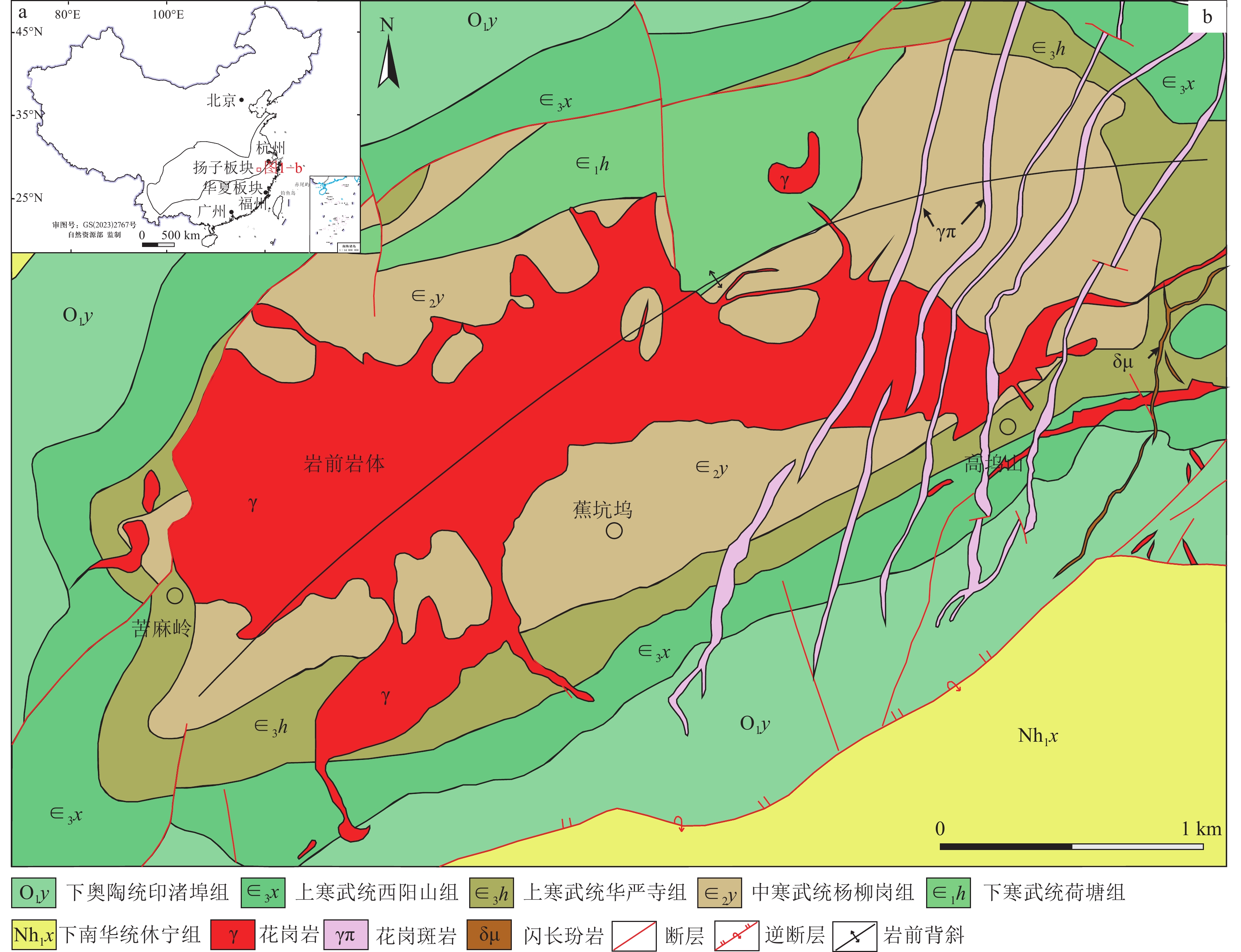
 下载:
下载:
